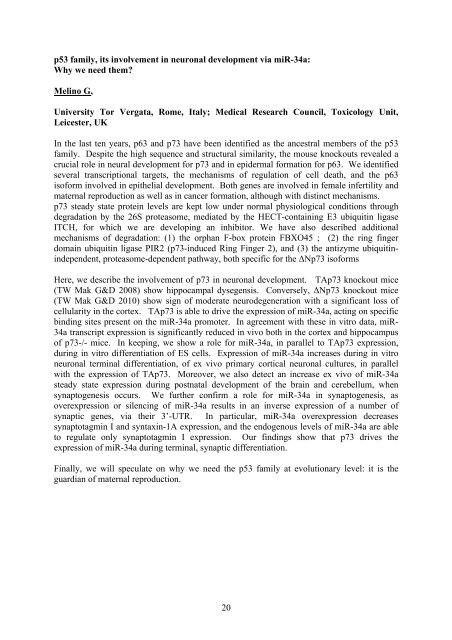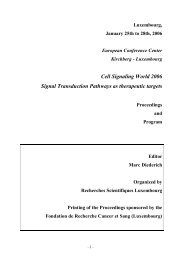Abstract book (download .pdf file) - Redox and Inflammation ...
Abstract book (download .pdf file) - Redox and Inflammation ...
Abstract book (download .pdf file) - Redox and Inflammation ...
Create successful ePaper yourself
Turn your PDF publications into a flip-book with our unique Google optimized e-Paper software.
p53 family, its involvement in neuronal development via miR-34a:<br />
Why we need them?<br />
Melino G,<br />
University Tor Vergata, Rome, Italy; Medical Research Council, Toxicology Unit,<br />
Leicester, UK<br />
In the last ten years, p63 <strong>and</strong> p73 have been identified as the ancestral members of the p53<br />
family. Despite the high sequence <strong>and</strong> structural similarity, the mouse knockouts revealed a<br />
crucial role in neural development for p73 <strong>and</strong> in epidermal formation for p63. We identified<br />
several transcriptional targets, the mechanisms of regulation of cell death, <strong>and</strong> the p63<br />
isoform involved in epithelial development. Both genes are involved in female infertility <strong>and</strong><br />
maternal reproduction as well as in cancer formation, although with distinct mechanisms.<br />
p73 steady state protein levels are kept low under normal physiological conditions through<br />
degradation by the 26S proteasome, mediated by the HECT-containing E3 ubiquitin ligase<br />
ITCH, for which we are developing an inhibitor. We have also described additional<br />
mechanisms of degradation: (1) the orphan F-box protein FBXO45 ; (2) the ring finger<br />
domain ubiquitin ligase PIR2 (p73-induced Ring Finger 2), <strong>and</strong> (3) the antizyme ubiquitinindependent,<br />
proteasome-dependent pathway, both specific for the !Np73 isoforms<br />
Here, we describe the involvement of p73 in neuronal development. TAp73 knockout mice<br />
(TW Mak G&D 2008) show hippocampal dysegensis. Conversely, !Np73 knockout mice<br />
(TW Mak G&D 2010) show sign of moderate neurodegeneration with a significant loss of<br />
cellularity in the cortex. TAp73 is able to drive the expression of miR-34a, acting on specific<br />
binding sites present on the miR-34a promoter. In agreement with these in vitro data, miR-<br />
34a transcript expression is significantly reduced in vivo both in the cortex <strong>and</strong> hippocampus<br />
of p73-/- mice. In keeping, we show a role for miR-34a, in parallel to TAp73 expression,<br />
during in vitro differentiation of ES cells. Expression of miR-34a increases during in vitro<br />
neuronal terminal differentiation, of ex vivo primary cortical neuronal cultures, in parallel<br />
with the expression of TAp73. Moreover, we also detect an increase ex vivo of miR-34a<br />
steady state expression during postnatal development of the brain <strong>and</strong> cerebellum, when<br />
synaptogenesis occurs. We further confirm a role for miR-34a in synaptogenesis, as<br />
overexpression or silencing of miR-34a results in an inverse expression of a number of<br />
synaptic genes, via their 3’-UTR. In particular, miR-34a overexpression decreases<br />
synaptotagmin I <strong>and</strong> syntaxin-1A expression, <strong>and</strong> the endogenous levels of miR-34a are able<br />
to regulate only synaptotagmin I expression. Our findings show that p73 drives the<br />
expression of miR-34a during terminal, synaptic differentiation.<br />
Finally, we will speculate on why we need the p53 family at evolutionary level: it is the<br />
guardian of maternal reproduction.<br />
20




